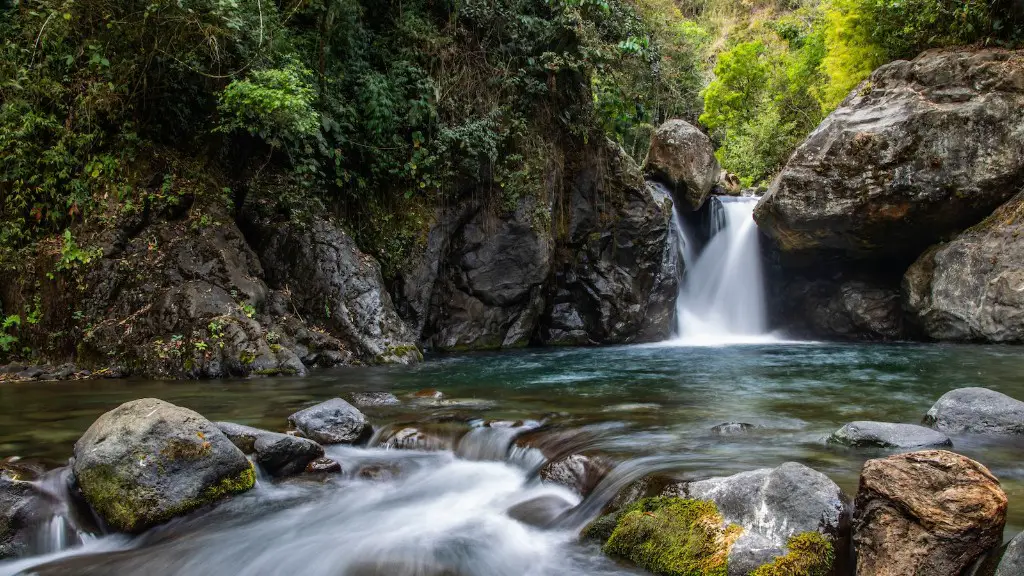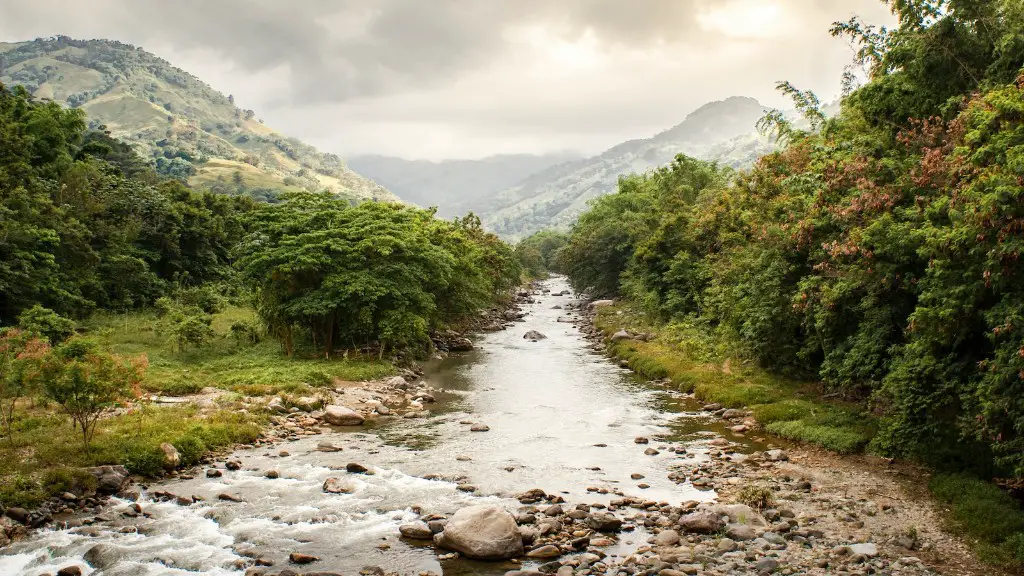The meandering Mississippi River is home to a wide array of animals, which makes it one of the most diverse aquatic ecosystems in the United States. This river runs over 2300 miles from northern Minnesota, through the heart of the Midwest and down through the Gulf of Mexico. It is home to a variety of fish species, amphibians, reptiles, mammals and birds, some of which are endemic to the Mississippi River system.
The primary fish species that inhabit the Mississippi are bass, catfish, panfish, sturgeon, and paddlefish. Sturgeon, an ancient fish species, have been living in the river for thousands of years and can reach up to eight feet in length and weigh hundreds of pounds. Paddlefish, also an ancient species, are filter feeders that feed on plankton, tiny organisms that make up the base of the aquatic food chain.
The Mississippi is also home to numerous species of amphibians, among them frogs, salamanders and toads. The most common amphibian species in the river are American Toads and Green Frogs. These frogs are typically found in pools of slow moving water and are a common sight along the riverbanks.
Reptiles, such as turtles, snakes and alligators also inhabit the Mississippi, although sightings of these animals are much rarer. The most commonly seen reptile, especially during the spring and summer months, are snapping turtles and water snakes. Alligators are occasionally spotted in some parts of the river, usually in southern Louisiana and southeastern Mississippi.
The Mississippi River supports a substantial amount of mammals, such as river otters, beavers, muskrats, and mink. These mammals are typically found near the shoreline and in shallow, slow moving sections of the river. River otters are especially common, as they are well adapted for life in the water and depend on the river for their food.
The Mississippi also has a variety of bird species living along its banks. Among them are Bald Eagles and Ospreys, two majestic birds of prey that feed on the fish that inhabit the river and its tributaries. Other common species include ducks and geese, herons, rails, and of course the iconic American crow.
Threats to the Animals of the Mississippi River
The human impact on the Mississippi River has been severe and has had a great toll on the animals that inhabit the river. For example, pollution from wastewater and fertilizer runoff have severely impacted water quality, making the river less hospitable to certain species. Additionally, many species have become endangered due to overfishing and habitat destruction.
Additionally, the introduction of invasive species, such as the Asian carp, has dealt a devastating blow to the river’s native species. This species, which was introduced in the 1960s, has out competed many of the river’s native species, such as the paddlefish, for food and resources. This competition has resulted in a drastic decrease in the population of the river’s native species, causing many to be listed as endangered.
The construction of dams and locks along the Mississippi further contribute to the destruction of animal habitats. These dams alter the landscape of the river and create unnatural barriers between certain areas, preventing certain species from reaching certain areas. Additionally, these barriers can cause fish to become trapped, leading to their demise.
Conservation Efforts for the Animals of the Mississippi River
Luckily, there are a number of organizations and initiatives working to conserve and protect the animals of the Mississippi River. Organizations such as the Nature Conservancy, WWF, and the National Wildlife Federation work to reduce the human impact on the river and its surrounding areas. These organizations focus on education, grassroot efforts and restoration projects in order to protect the fish and wildlife of the Mississippi River.
The U.S Fish and Wildlife Service has also established a number of preserves and refuges that provide essential habitats for the animals of the Mississippi. These areas are free of human disturbance, which allows them to remain unaltered and provide the necessary resources that allow the species living there to thrive.
Finally, the Fish and Wildlife Service has implemented numerous archeological and biological surveys in order to increase public awareness of the dangers faced by the animals of the Mississippi River. These surveys provide valuable data and information that is used to inform both conservation initiatives and public education efforts.
The Social and Cultural Significance of the Mississippi River Animals
The Mississippi River has a deep cultural and spiritual meaning for many people living in the Midwest. It is a central component in the region’s mythology and folklore and has been an integral part of many Native American cultures for centuries. The animals of the Mississippi are a key part of this mythology, and many of them have become symbols of strength, courage and resilience.
The Bald Eagle, in particular, is a symbol of national pride and has become a powerful symbol of America. The majestic Osprey, on the other hand, is a symbol of determination, endurance and perseverance. Both of these birds are commonly seen along the Mississippi and their presence serves as a reminder of the river’s history and beauty.
The fish species that inhabit the Mississippi also have a great significance to many people. The paddlefish, for example, was once revered as a sacred species by many Native American tribes and is still a symbol of strength and power. The sturgeon, being an ancient species, is believed to have been a symbol of longevity and resilience by many cultures.
The Role of Individuals in Protecting the Mississippi River Animals
In order to ensure the protection of the animals of the Mississippi River, individual citizens need to take an active role in conservation efforts. This can be done in a variety of ways, such as avoiding activities that would disturb the animals’ habitats, reducing fertilizer use near the river and riverside, and responsibly disposing of fishing line and tackle.
Individuals can also join conservation organizations, such as the Nature Conservancy, WWF, and the National Wildlife Federation, to help fund research and restoration efforts. Additionally, individuals can choose to buy their seafood from environmentally friendly sources, such as sustainable fisheries, in order to reduce the amount of pressure placed on the river’s fish populations.
Finally, individuals can lessen the impact of pollution on the river by properly disposing of waste and participating in river cleanups. By removing trash and debris from the banks of the Mississippi, individuals can help reduce the amount of pollution entering the water.
The Future of the Mississippi River Animals
Despite the numerous threats facing the animals of the Mississippi River, organizations and initiatives are making great strides in conservation. With the help of individuals, laws, and new technologies, it is possible to restore the river’s habitats and populations and ensure that these majestic creatures can continue to thrive.
The Mississippi River and its animals are integral pieces of the region’s history and culture, and it is up to us to ensure that these species are preserved for future generations. In order to do this, we must work together to restore the river’s habitats, reduce our impact on the river and spread awareness about the importance of protecting its wildlife.
Potential Research and Restoration Efforts
In order to ensure the protection of the Mississippi River’s animal populations, research and restoration efforts must be implemented. This includes studying the river’s habitats and species, as well as determining the best ways to reduce the human impact on the river and its inhabitants.
Restoration projects, such as riverbank stabilization and the reestablishment of wetlands, can also help provide critical habitats for the animals of the Mississippi. Additionally, fish restocking programs can be implemented in order to restore nutrient and biodiversity in the river.
Finally, it is also important to work towards reducing the threats of invasive species. This can be accomplished by altering certain activities that have a negative effect on the river’s habitats. For example, educating people on the impact of carp fishing on native species and encouraging alternative forms of fishing can help prevent the spread of invasive species.
Closing Thoughts
The animals of the Mississippi River are invaluable pieces of the region’s history and culture, and it is our responsibility to ensure that they are properly protected. By working together and taking an active role in conservation efforts, we can ensure that these magnificent animals continue to thrive in the waters of the mighty Mississippi.





